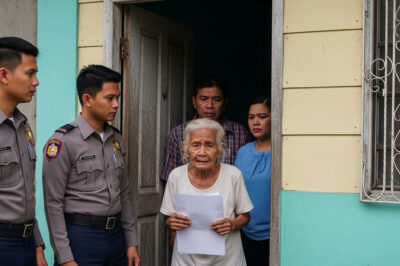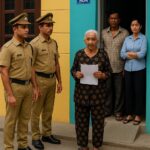Because of a government project, the barangay residents decided to cut down the hundred-year-old ballet tree in front of the old chapel to open a new road. But that night, the entire village suddenly lost power, lightning and thunder struck one after another. The next day, every house with a young child woke up to a nightmare…
Barangay Tinagong Bato is tucked away in the foothills of the Nueva Ecija mountains , a place known for its quiet and legendary history. Opposite the village’s old chapel, there is a giant balete tree that the elders call “Lola Balete.” The roots are wide, the leaves are thick, and it takes two to three people to hug the entire tree.
This is where children play, barangay meetings are held, and it is also where the scolding is carried out whenever someone in the community feels something is wrong.

But the time has come for the Build, Build, Build project. Barangay Tinagong Bato has been included in the list of routes for the new national highway. The sad thing is? The road is hitting the very spot where the main ballet stands.
After many meetings and tense discussions, Captain Arturo Liwanag , the barangay chief, signed the consent document: the ballet will be cut for the road of development.
Even though it was heavy inside, he said:
“We can’t stop at the myth. We need to open up space for progress. For the future of children.”
The most vocal opponent was Tatay Melencio , 87 years old, a renowned herbalist and keeper of local history. When he heard that the ballet would be cut, he whispered to his grandson:
“That’s not just a tree. That’s the guardian of this land. If you touch it, you’ll awaken the past.”
His grandson Ryan , a third-year Civil Engineering student from Manila, went home for vacation. He replied:
“Dad, this is the time for science. There are no ‘ghosts’ in engineering. It’s even more dangerous to keep that—you might get struck by lightning.”
Father Melencio never spoke again. But the night before the tree was cut down, he went under it, lit a candle, and prayed softly while comforting the tree like an old friend.
The next day , the workers arrived. They brought a chainsaw, a backhoe, and several officials from the municipality.
The first branch was cut, and the roof of the chapel was broken. Someone shouted. Someone said “bad omen.” But the work continued. By afternoon, the tree had become nothing but a stump. Chemicals were poured so that the roots would die completely.
After all, the people had gone home. It was quiet. No one greeted each other.
It was night. The wind was strong. Lightning struck one after another. At eleven o’clock at night, the entire barangay suddenly lost electricity.
The children were crying. The adults were holding candles.
A little while later… there was a knocking sound on the ground. There was a girl’s laughter outside the windows.
But when I looked up—it was pitch black.
In Father Melencio’s house, there was no sleep. He was sitting in front of the altar, holding an old rosary.
The next day, the entire village was in complete panic:
Seven children never woke up from their sleep. They were not dead. But they were not conscious either. They were not sick either. The health worker said: “It was like they were sleeping, but we couldn’t explain why they wouldn’t wake up.”
Three of those children are the grandchildren of Kap Arturo, Kagawad Cesar, and Ingat-Yaman Linda—three of those who signed to cut the ballet.
All eyes looked at the dried roots of the ballet tree.
Ryan approached Father Melencio. He didn’t say anything. The old man just handed him a thick notebook — his father’s handwriting from the time of the Japanese.
Ryan read:
“This ballet is guarded by the soul of a woman killed in the midst of war—Aling Maria, a blind fortune teller who was accused of treason and tortured by soldiers. While being beaten in the shadow of the ballet, she said:
‘I will not take my anger to heaven—I will leave it here. I will return when the ungrateful have disregarded the memories.’ ”
And as cursed, Aling Maria committed suicide in the shadow of the ballet that night.
Since then, during every festival and Holy Week, the main ballet has been adorned with candles and flowers. Nothing moves here. Until this year.
On the last page of the notebook, written in Baybayin:
“If the body is severed, the spirit must be revived. Asking for forgiveness is the path to awakening.”
On the afternoon of the second day , Captain Arturo called a meeting.
In the middle of the plaza, in front of the stump of the ballet, he knelt down.
“I signed. I led the cutting. I didn’t think about history. Now, I beg you—forgive us. Save the children.”
One by one, people approached. They brought offerings: sweet potatoes, bananas, salt, rainwater, fried rice—foods of the common people. Everyone prayed.
Father Melencio, wearing a Tagalog robe, stood in front of the stump:
“If ballet is the witness to sin, may it also be the bridge to forgiveness. We face it again—not as sinners, but as children willing to humble themselves.”
That night—the first night without rain, without thunder.
The next day, the children woke up one by one.
Thalia, Kagawad Linda’s youngest daughter, said:
“I had a dream. There was an old woman, dressed in white, sitting under a tree. She said, ‘It’s not your fault, go home.’”
After the incident , the barangay council decided: no building would be built on the site of the main ballet. Instead, a small shrine would be built here — in memory of Aling Maria , the barangay custodian at the time.
The road? It continued. But the ballet area was bypassed , respecting history.
Ryan? Returned to university with a new goal.
His thesis is titled:
“Infrastructure Development and the Value of Cultural Heritage in the Provinces of the Philippines.”
In Barangay Tinagong Bato, everyone learned a lesson:
Respect for the past is not an obstacle to progress.
There are memories that should never be erased—because they are where our identity is rooted.
News
THEY TOLD US HE D!3D IN THE LINE OF DUTY—BUT HIS DOG KNEW BETTER. /dn
THEY TOLD US HE D!3D IN THE LINE OF DUTY—BUT HIS DOG KNEW BETTER. The funeral was full of the…
My stepson pulled me aside before the wedding and whispered, “Don’t marry my dad.” /dn
My stepson pulled me aside before the wedding and whispered, “Don’t marry my dad.” The hallway outside the ballroom was…
My dad brought me to prom in a wheelchair, then we found a $10,000 check./dn
My dad brought me to prom in a wheelchair, then we found a $10,000 check. If someone had told me…
An Elderly Mother Sold All Her Land to Pay Off Her Son’s Debt — Three Months Later, The Son They Helped Kicked Them Out. But Little Did The Couple Know… That The Mother Reported Her to the Police Just a Week Ago — and She Already Has a Plan. /dn
An Elderly Mother Sold All Her Land to Pay Off Her Son’s Debt — Three Months Later, The Son They…
Mother-in-Law Notices Daughter-in-Law Staying in the Bathroom for Over an Hour Every Night — One Night, She Listens at the Door… and Immediately Calls the P0l1ce!
Every Night, My Daughter-in-Law Took an Hour-Long Shower — One Evening, I Secretly Listened at the Door and Immediately Called…
Mute for three years, she spoke when he knelt. /dn
Mute for three years, she spoke when he knelt. No one at the company really noticed her. She came in…
End of content
No more pages to load












